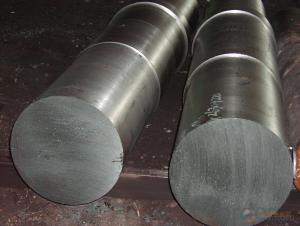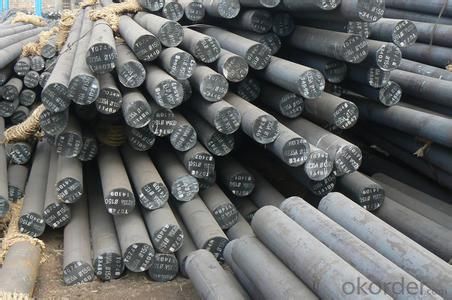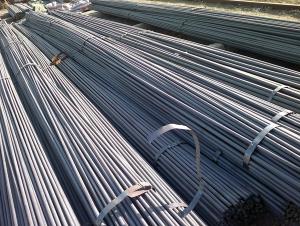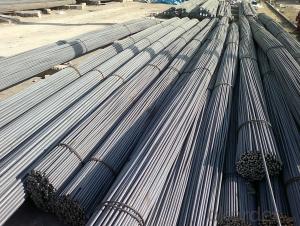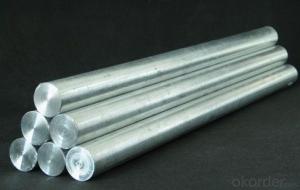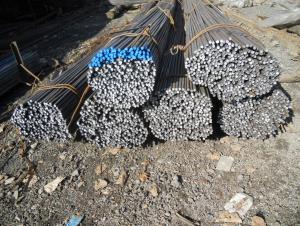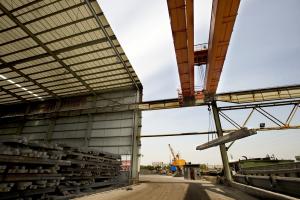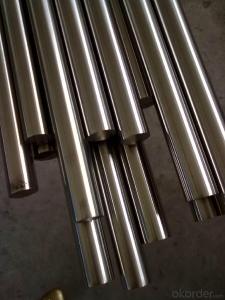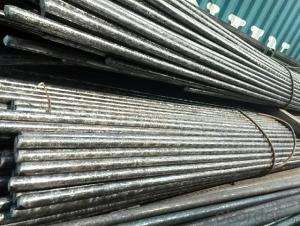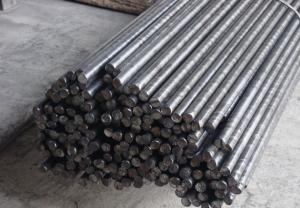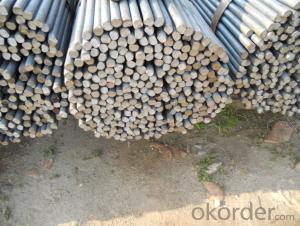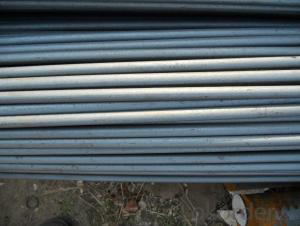Alloyed steel round bar
- Loading Port:
- China Main Port
- Payment Terms:
- TT OR LC
- Min Order Qty:
- -
- Supply Capability:
- -
OKorder Service Pledge
Quality Product, Order Online Tracking, Timely Delivery
OKorder Financial Service
Credit Rating, Credit Services, Credit Purchasing
You Might Also Like
Quick Details
| Steel Grade: | Standard: | Dimensions: | |||
| Place of Origin: | Brand Name: | Model Number: | |||
| Technique: | Application: | Alloy Or Not: | |||
| Special Use: | Type: | LENGTH: | |||
| COMMODITY: | SPEC: | SIZE: |
Packaging & Delivery
| Packaging Detail: | Packing Term: Bulk Packing Or Container. |
| Delivery Detail: | Within 30-45 days as of the date of contract signing |
Specifications
ROUND BAR (S45C,S20C,SS400,A36)
1.Length:6m to 12m
2.Grade:Q235/SS400/S20C/S45C
Remarks:
1.Origin / Manufacturer: China
2.Port of Loading: Tianjin Port,China
3.Packing Term: Bulk Packing Or Container
4.Measurement of Weight: By Theoretical Weighting
5.Certificate:ISO9001,CIC,BV,SGS
- Q: Can steel round bars be used in the manufacturing of electrical components?
- Yes, steel round bars can be used in the manufacturing of electrical components. Steel is a commonly used material in various industries due to its strength, durability, and electrical conductivity. Steel round bars can be shaped, cut, and machined to form different components such as connectors, terminals, and housings for electrical devices. Additionally, steel's corrosion resistance and affordable cost make it a practical choice for manufacturing electrical components.
- Q: Can steel round bars be used for making conveyor belts or rollers?
- Yes, steel round bars can indeed be used for making conveyor belts or rollers. Steel is a strong and durable material with excellent tensile strength, making it suitable for applications where heavy loads or continuous movement is involved. The round bars can be used to create the structural framework or support system of the conveyor belt or roller, providing stability and rigidity. Additionally, steel is resistant to wear and tear, and can withstand high temperatures, making it ideal for industrial settings. However, it's important to consider other factors such as the specific requirements of the conveyor system, the type of material being transported, and any potential corrosion issues that may arise.
- Q: What are the different types of steel round bars used in the defense industry?
- There are several different types of steel round bars that are commonly used in the defense industry. These materials are specifically chosen for their strength, durability, and ability to withstand harsh conditions. Some of the most commonly used steel round bars in the defense industry include: 1. High-strength low-alloy (HSLA) steel round bars: These bars are known for their high strength-to-weight ratio, making them ideal for applications where weight reduction is important. HSLA steel round bars are often used in the construction of armored vehicles, tanks, and other military equipment. 2. Stainless steel round bars: Stainless steel is highly resistant to corrosion and rust, making it an excellent choice for defense applications where exposure to moisture or harsh environments is common. Stainless steel round bars are frequently used in the manufacturing of military aircraft, naval vessels, and firearms. 3. Carbon steel round bars: Carbon steel is a versatile and cost-effective material that is widely used in the defense industry. It offers excellent strength and hardness, making it suitable for various applications such as missile components, gun barrels, and armor plates. 4. Alloy steel round bars: Alloy steel is a combination of different metals, typically including chromium, molybdenum, and nickel, which enhances its mechanical properties. Alloy steel round bars are commonly utilized in the production of military-grade vehicles, artillery systems, and munitions. 5. Tool steel round bars: Tool steel is specifically designed to have exceptional hardness, wear resistance, and toughness. It is often used for manufacturing cutting tools, drills, and other equipment used in the defense industry. Each type of steel round bar has its own unique properties and advantages, allowing it to fulfill specific requirements in the defense sector. The selection of the appropriate steel round bar depends on the specific application and the desired performance characteristics needed to meet the demands of the defense industry.
- Q: What is the maximum hardness achievable for steel round bars?
- The maximum hardness attainable for steel round bars relies on various factors, including the steel's composition, the heat treatment process, and the desired properties for the specific application. Typically, steel can reach a maximum hardness of approximately 65 HRC or higher. This level of hardness is commonly achieved through procedures like quenching and tempering. Quenching entails rapidly cooling the steel from a high temperature to room temperature, resulting in a hardened structure. Subsequently, tempering is carried out to decrease brittleness and enhance the steel's toughness while maintaining a high level of hardness. It is crucial to acknowledge that pushing the hardness of steel beyond a certain point may result in reduced toughness and increased brittleness. Hence, the maximum attainable hardness must be balanced with the desired properties for the particular application, such as strength, ductility, and resistance to wear or impact.
- Q: How are steel round bars used in the construction of dams and reservoirs?
- Steel round bars are essential components in the construction of dams and reservoirs due to their strength, durability, and versatility. These bars, typically made of reinforced steel, play a crucial role in reinforcing the concrete structures that make up dams and reservoirs. One of the primary uses of steel round bars in dam construction is as reinforcement in concrete walls and foundations. The bars are strategically placed within the concrete to provide additional tensile strength, preventing cracking and ensuring structural integrity. The reinforcement helps withstand the enormous pressure exerted by the water, preventing leaks or potential failures. Moreover, steel round bars are utilized to strengthen the spillway gates and control structures of dams and reservoirs. These gates are responsible for regulating the flow of water and preventing overflow during heavy rains or floods. By reinforcing these critical areas with steel round bars, engineers can ensure that the gates can withstand the forces exerted by the flowing water, maintaining their functionality and preventing any potential damage. Additionally, steel round bars are employed in the construction of penstocks, which are large pipes or conduits that carry water from the reservoirs to the turbines in hydroelectric power plants. These bars reinforce the penstocks, ensuring they can withstand the high pressure of the water as it flows through and powers the turbines. In summary, steel round bars are widely used in the construction of dams and reservoirs to enhance the strength and durability of various structural components. Their ability to reinforce concrete walls, foundations, spillway gates, control structures, and penstocks makes them indispensable in ensuring the longevity and stability of these vital water infrastructures.
- Q: How to distinguish a round bar from forging? Cold drawing? Hot rolling?
- Round bar is divided into three parts: hot rolling, forging and cold drawing. Standard Specification for hot rolled round steel is 5.5-250 mm. Where: 5.5-25 mm small round steel mostly straight bundles of supply, used for steel, bolts and various mechanical parts; greater than 25 mm round steel, seamless steel pipe is mainly used for the manufacture of mechanical parts of the tube, etc..
- Q: Can steel round bars be used in corrosive environments?
- Steel round bars can be used in corrosive environments, but their suitability depends on the specific type of steel and the severity of the corrosion. Stainless steel round bars, for example, are known for their excellent corrosion resistance and are commonly used in corrosive environments such as marine applications, chemical processing plants, and wastewater treatment facilities. These bars are typically alloyed with elements like chromium and nickel, which form a protective layer on the steel surface, preventing corrosion. However, carbon steel round bars are more prone to corrosion and may not be suitable for highly corrosive environments without proper coatings or treatments. In such cases, it is important to consult with experts or engineers to select the appropriate steel grade and take necessary precautions to ensure the longevity and performance of steel round bars in corrosive environments.
- Q: Can steel round bars be used for making bicycle frames or handlebars?
- Yes, steel round bars can be used for making bicycle frames or handlebars. Steel is a commonly used material in bicycle manufacturing due to its strength, durability, and affordability. Round bars made of steel provide excellent rigidity and stability, which are essential for ensuring the structural integrity of a bicycle frame or handlebars. Additionally, steel has a high tensile strength, allowing it to withstand the stresses and strains experienced during cycling. It is worth noting that different types of steel, such as chromoly steel, may be preferred for bicycle frames and handlebars as they offer specific advantages such as improved strength-to-weight ratio. However, in general, steel round bars are a suitable choice for constructing bicycle frames and handlebars.
- Q: What is the difference between a turned and a ground steel round bar?
- A turned steel round bar and a ground steel round bar are two different types of steel bars that have undergone different manufacturing processes. A turned steel round bar is created by rotating a cylindrical steel rod against a cutting tool, which removes material from the surface of the bar to achieve the desired dimensions and finish. This process helps to improve the dimensional accuracy and smoothness of the bar's surface. Turned steel round bars are commonly used in applications that require tight tolerances and a smooth surface finish, such as in precision machining or automotive components. On the other hand, a ground steel round bar is manufactured by passing a turned steel round bar through a grinding machine. This machine uses an abrasive wheel to remove any surface imperfections or irregularities from the bar. The grinding process ensures that the bar has a consistent diameter and a smooth, polished surface. Ground steel round bars are often used in applications that require a high level of precision and surface finish, such as in aerospace components or hydraulic cylinders. In summary, the main difference between a turned and a ground steel round bar lies in the manufacturing processes they undergo. While turned bars are created by cutting material from the surface, ground bars are refined by grinding to achieve superior dimensional accuracy and surface smoothness. The choice between turned and ground steel round bars depends on the specific requirements of the application and the level of precision and surface finish needed.
- Q: What are the different types of steel round bar surface treatments?
- The different types of steel round bar surface treatments include hot-dip galvanizing, electroplating, powder coating, and painting.
Send your message to us
Alloyed steel round bar
- Loading Port:
- China Main Port
- Payment Terms:
- TT OR LC
- Min Order Qty:
- -
- Supply Capability:
- -
OKorder Service Pledge
Quality Product, Order Online Tracking, Timely Delivery
OKorder Financial Service
Credit Rating, Credit Services, Credit Purchasing
Similar products
Hot products
Hot Searches
Related keywords
